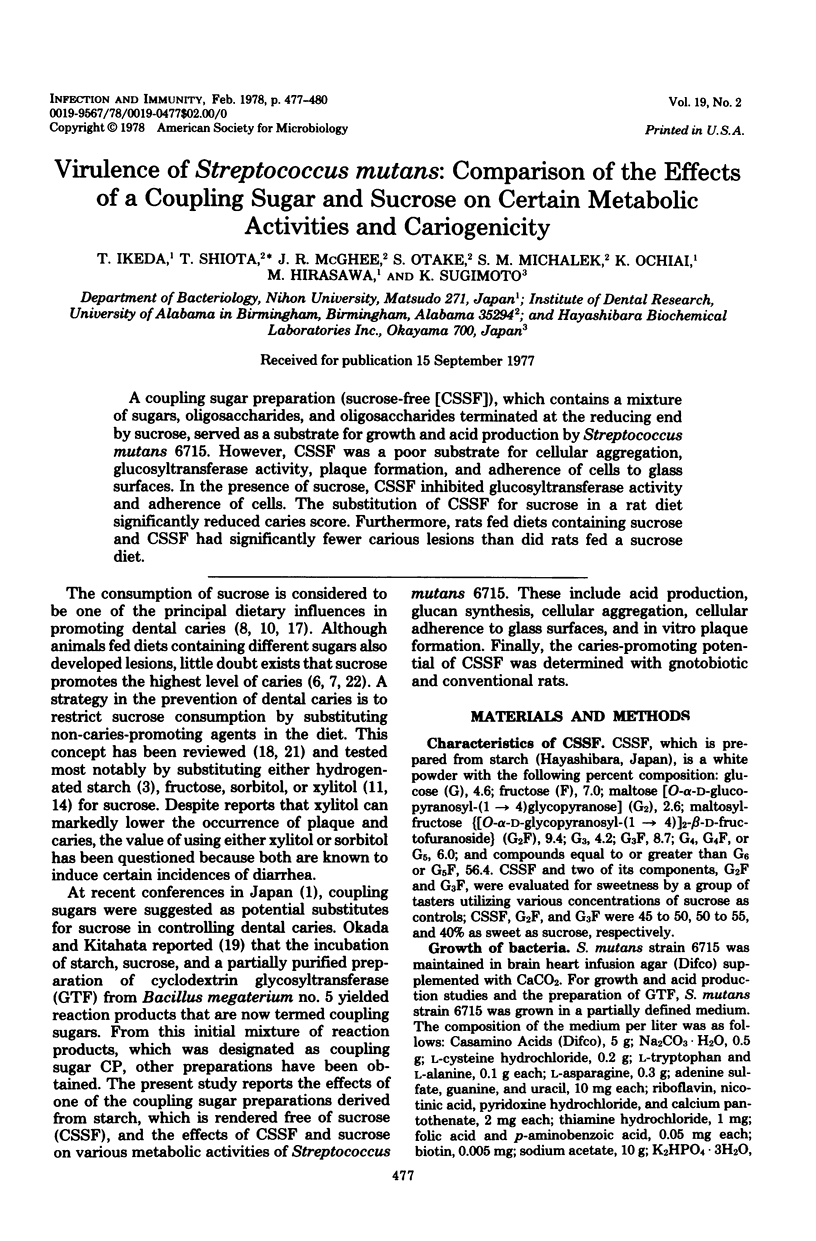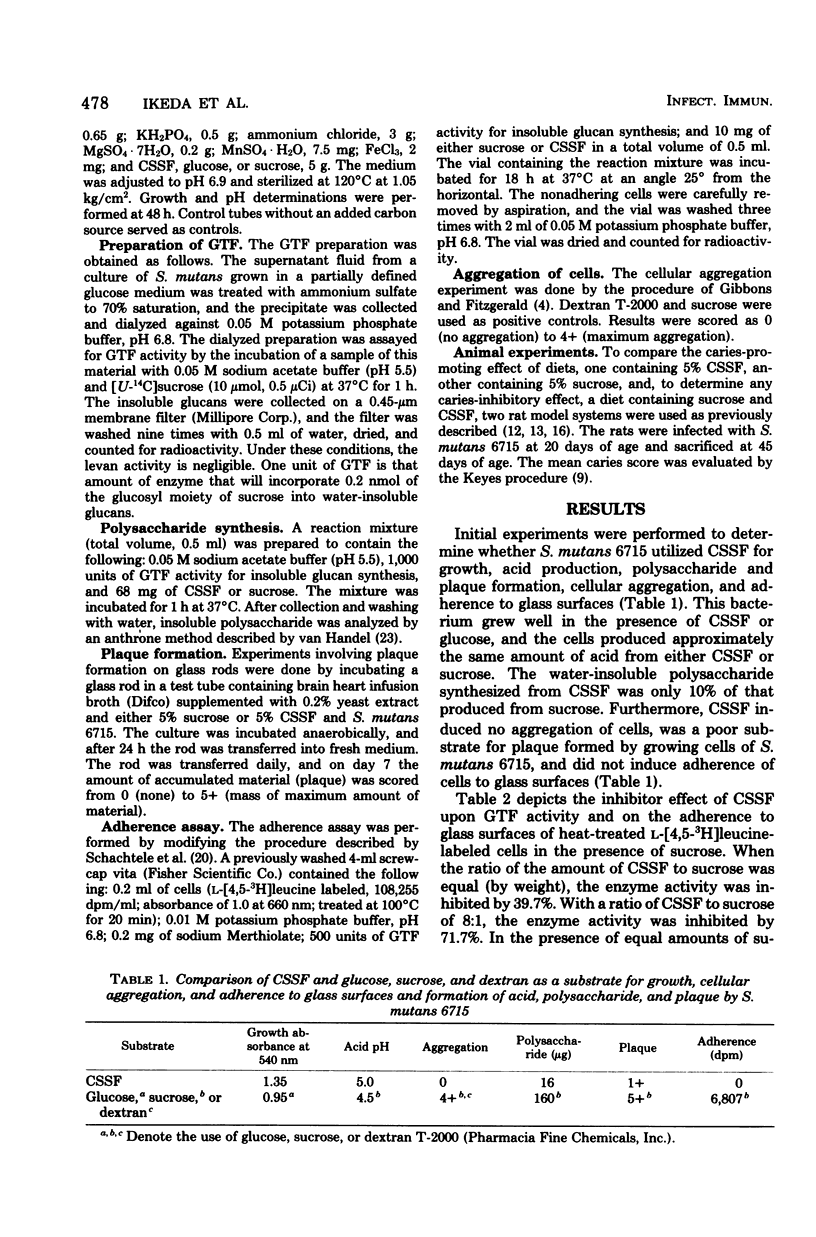Abstract
A coupling sugar preparation (sucrose-free [CSSF]), which contains a mixture of sugars, oligosaccharides, and oligosaccharides terminated at the reducing end by sucrose, served as a substrate for growth and acid production by Streptococcus mutans 6715. However, CSSF was a poor substrate for cellular aggregation, glucosyltransferase activity, plaque formation, and adherence of cells to glass surfaces. In the presence of sucrose, CSSF inhibited glucosyltransfer activity and adherence of cells. The substitution of CSSF for sucrose in a rat diet significantly reduced caries score. Furthermore, rats fed diets containing sucrose and CSSF had significantly fewer carious lesions than did rats fed a sucrose diet.
Full text
PDF



Selected References
These references are in PubMed. This may not be the complete list of references from this article.
- Chludzinski A. M., Germaine G. R., Schachtele C. F. Purification and properties of dextransucrase from Streptococcus mutans. J Bacteriol. 1974 Apr;118(1):1–7. doi: 10.1128/jb.118.1.1-7.1974. [DOI] [PMC free article] [PubMed] [Google Scholar]
- Frostell G., Keyes P. H., Larson R. H. Effect of various sugars and sugar substitutes on dental caries in hamsters and rats. J Nutr. 1967 Sep;93(1):65–76. doi: 10.1093/jn/93.1.65. [DOI] [PubMed] [Google Scholar]
- GUSTAFSSON B. E., QUENSEL C. E., LANKE L. S., LUNDQVIST C., GRAHNEN H., BONOW B. E., KRASSE B. The Vipeholm dental caries study; the effect of different levels of carbohydrate intake on caries activity in 436 individuals observed for five years. Acta Odontol Scand. 1954 Sep;11(3-4):232–264. doi: 10.3109/00016355308993925. [DOI] [PubMed] [Google Scholar]
- Gibbons R. J., Fitzgerald R. J. Dextran-induced agglutination of Streptococcus mutans, and its potential role in the formation of microbial dental plaques. J Bacteriol. 1969 May;98(2):341–346. doi: 10.1128/jb.98.2.341-346.1969. [DOI] [PMC free article] [PubMed] [Google Scholar]
- Gibbons R. J., Nygaard M. Synthesis of insoluble dextran and its significance in the formation of gelatinous deposits by plaque-forming streptococci. Arch Oral Biol. 1968 Oct;13(10):1249–1262. doi: 10.1016/0003-9969(68)90081-2. [DOI] [PubMed] [Google Scholar]
- Green R. M., Hartles R. L. The effect of diets contaning different mono- and disaccharides on the incidence of dental caries in the albino rat. Arch Oral Biol. 1969 Mar;14(3):235–241. doi: 10.1016/0003-9969(69)90225-8. [DOI] [PubMed] [Google Scholar]
- Guggenheim B., König K. G., Herzog E., Mühlemann H. R. The cariogenicity of different dietary carbohydrates tested on rats in relative gnotobiosis with a Streptococcus producing extracellular polysaccharide. Helv Odontol Acta. 1966 Oct;10(2):101–113. [PubMed] [Google Scholar]
- KEYES P. H. Dental caries in the molar teeth of rats. II. A method for diagnosing and scoring several types of lesions simultaneously. J Dent Res. 1958 Nov-Dec;37(6):1088–1099. doi: 10.1177/00220345580370060901. [DOI] [PubMed] [Google Scholar]
- Michalek S. M., McGhee J. R., Navia J. M. Virulence of Streptococcus mutans: a sensitive method for evaluating cariogenicity in young gnotobiotic rats. Infect Immun. 1975 Jul;12(1):69–75. doi: 10.1128/iai.12.1.69-75.1975. [DOI] [PMC free article] [PubMed] [Google Scholar]
- Michalek S. M., McGhee J. R. Virulence of Streptococcus mutans: an antibiotic-suppressed rat model for studies of pathogenesis. J Dent Res. 1977 Mar;56(3):205–211. doi: 10.1177/00220345770560030301. [DOI] [PubMed] [Google Scholar]
- Mukasa H., Slade H. D. Mechanism of adherence of Streptococcus mutans to smooth surfaces. I. Roles of insoluble dextran-levan synthetase enzymes and cell wall polysaccharide antigen in plaque formation. Infect Immun. 1973 Oct;8(4):555–562. doi: 10.1128/iai.8.4.555-562.1973. [DOI] [PMC free article] [PubMed] [Google Scholar]
- Mäkinen K. K. Dental aspects of the consumption of xylitol and fructose diets. Int Dent J. 1976 Mar;26(1):14–28. [PubMed] [Google Scholar]
- Mühlemann H. R., Regolati B., Marthaler T. M. The effect on rat fissure caries of xylitol and sorbitol. Helv Odontol Acta. 1970 Apr;14(1):48–50. [PubMed] [Google Scholar]
- Newbrun E. Sucrose, the arch criminal of dental caries. Odontol Revy. 1967;18(4):373–386. [PubMed] [Google Scholar]
- Newbrun E. Sugar, sugar substitutes and noncaloric sweetening agents. Int Dent J. 1973 Jun;23(2):328–345. [PubMed] [Google Scholar]
- Schachtele C. F., Staat R. H., Harlander S. K. Dextranases from oral bacteria: inhibition of water-insoluble glucan production and adherence to smooth surfaces by Streptococcus mutans. Infect Immun. 1975 Aug;12(2):309–317. doi: 10.1128/iai.12.2.309-317.1975. [DOI] [PMC free article] [PubMed] [Google Scholar]
- Scheinin A. Dietary sugars and sugar substitutes. Int Dent J. 1973 Sep;23(3):427–431. [PubMed] [Google Scholar]
- Shaw J. H., Krumins I., Gibbons R. J. Comparison of sucrose, lactose, maltose and glucose in the causation of experimental oral diseases. Arch Oral Biol. 1967 Jun;12(6):755–768. doi: 10.1016/0003-9969(67)90211-7. [DOI] [PubMed] [Google Scholar]
- Van Handel E. Direct microdetermination of sucrose. Anal Biochem. 1968 Feb;22(2):280–283. doi: 10.1016/0003-2697(68)90317-5. [DOI] [PubMed] [Google Scholar]


